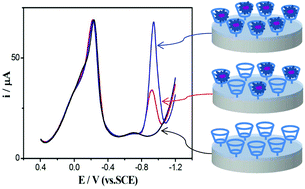A ratiometric strategy -based electrochemical sensing interface for the sensitive and reliable detection of imidacloprid†
Abstract
In this study, a ratiometric strategy-based electrochemical sensor was developed by electropolymerization of thionine (THI) and β-cyclodextrin (β-CD) composite films on a glassy carbon electrode surface for imidacloprid (IMI) detection. THI played the role of an inner reference element to provide a built-in correction. In addition, the modified β-CD showed good selective enrichment for IMI to improve the sensitivity and anti-interference ability of the sensor. The current ratio between IMI and THI was calculated as the detected signal for IMI sensing. Compared with common single-signal sensing, the proposed ratiometric strategy showed a higher linear range and a lower limit of detection of 4.0 × 10−8–1.0 × 10−5 mol L−1 and 1.7 × 10−8 mol L−1, respectively, for IMI detection. On the other hand, the ratiometric strategy endowed the sensor with good accuracy, reproducibility, and stability. The sensor was also used for IMI determination in real samples with satisfactory results. The simple, effective, and reliable way reported in this study can be further used to prepare ratiometric strategy-based electrochemical sensors for the selective and sensitive detection of other compounds with good accuracy and stability.



 Please wait while we load your content...
Please wait while we load your content...